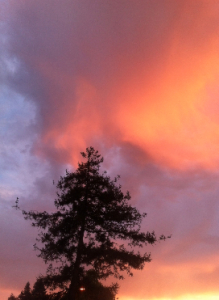Hi There,
Usually the summer weather in the Los Padres is pretty boring. This has not been the case of late. About a week ago, our interesting weather started with a southerly monsoonal flow that dropped bits of precipitation across the the region. Temps were hot along the inland side of the forest which resulted in some thunderstorms over portions of the backcountry. The best part of the week has been the cloud formations and lingering fog on the mountains. We heard reports from across the Los Padres of rainbows, winter-like cloud formations, both low hanging and high scattered that made for some great views and sunsets. Many easterners complain that California has no weather, but I think it makes us even more appreciative when weather does come in. We’ll see what happens next…….
Hope you like your Jameson dry? photo Humphrey, July 2014
We’re starting to get reports of water sources drying up around the Los Padres. Most of the Sespe is now dry outside of a few standing pools of water. Most of the reports from the Dick Smith/San Raf are showing dry creekbeds and the same goes for the San Luis Backcountry where flowing water is a rarity. Even the reliable creeks and rivers of the Northern LP are at low flow rates. Reliable springs are still flowing and most of the perennial streams have water, but it looks a lot like what September water conditions would look like during a normal year. If you are heading out for a hike or overnighter, be sure to bring extra amounts of water and always check in with the Forest Service or shoot us an email (info@LPForest.org) ahead of time to get the most recent water and trail information.
S A F E T Y
The Forest Service has passed on a few messages of late about safety procedures and processes. Trail leaders, please take a few minutes and read the notes below. Safety is always priority number one when on projects.
As most of you have heard, there was an incident on the Jemez Ranger District involving an explosive device that appears to have been deliberately placed at the base of an information sign. The device was constructed with a mason jar and had what appeared to be a protruding wick. It was placed on the ground with no camouflaging material to conceal it from view. When tapped with the boot of the individual, the device detonated. Thankfully, the individual’s injuries were minor. At present, the Bureau of Alcohol, Tobacco, Firearm, and Explosives has taken the lead on the investigation. No additional devices have been found on the Forest.
Due to this incident, many employees have expressed some concern about their safety while working in the field. So what can you do to protect yourself? First, stay vigilant and increase your “situational awareness.” Look up, down, and all around. If something appears “out of place” or “not quite right” (i.e. a suspicious looking object), do not disturb it! Move away from the area and immediately contact law enforcement. Second, work in pairs if possible so that a second person is right there in the event of an accident. Finally, always have appropriate communication devices readily available and be sure to adhere to our Forest’s Check-Out and Check-In Program.
Over the last few years we have had important conversations about organizational and individual safety. I truly believe the safer we are the more successful we are. Our mission of improving the health and resilience of our National Forests and providing public services to the American people can only be achieved with a focused attention on our safety and well-being.
I would ask each of you to take time now and periodically throughout each day to assess your safety situation and those you are responsible for. It is critical that you are prepared to take on your work safely, are confident that the work you are undertaking is worth the risk, and have a keen sense of your situational awareness whatever your work environment. I would also ask that you insure your behavior is consistent with the agreements you have made with yourself, your supervisor, and all who rely on you. I will never ask you to cut any corners on safety to get the work done.
In addition to expecting that each one of you personally lead up in safety, I expect that when unexpected outcomes occur that you notify your supervisor immediately so that we can understand what happened and can learn from the experience. Learning from unintended and unexpected outcomes will be key to our growth as a world-class safety organization. The primary tools we will use to accomplish this are Facilitated Learning Analyses and After Action Reviews.
At the end of every day and every assignment, every employee, partner, and volunteer who works on behalf of the Forest Service should return home safely. I am asking each and every one of you to help insure we accomplish this together.

Redwood Sunset, Wearing the Weather Well, North of Big Sur, July 17th

